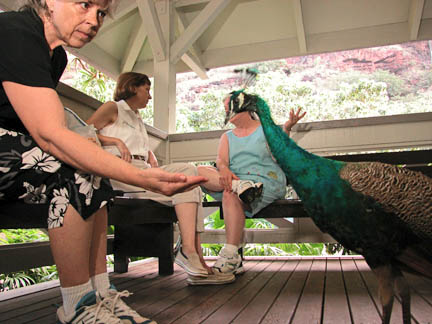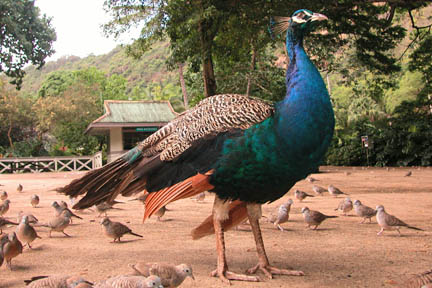

|
Pesky peafowl invade
back yards and parks
Randy Klein hears strange noises in the night: a tapping on the roof above his bedroom that just doesn't quit. And almost every time he plants a new herb in his garden, it gets uprooted.
Sometimes, when he leaves a plate of food on the lanai as he runs inside to answer the phone, something's missing when he returns.
Mysterious? Hardly. It's just a common case of birds behaving badly.
Klein, who lives in a small home at the base of the Koolaus in Maunawili, has a daily face-off with a fancy peacock.
According to Susan Arbuthnot, a bird expert with the Honolulu Zoo, Klein isn't the only one wondering how to keep the wild peafowl at bay. Her office receives calls each month from landowners who need advice on managing the problem of the not-so-friendly neighborhood peafowl.
"This is getting old," Klein said of the ongoing battle to keep the wild bird off his property. "I don't know what to do. I don't want to kill it, but I don't want it tearing up my garden and pecking at my roof. It can really drive you crazy."

|
Officials at Waimea Valley Audubon Center chose to deal with a similar problem about three weeks ago by killing nine peacocks to "thin" the growing population of birds that officials said have become a nuisance for park patrons. After complaints from the public, center officials apologized to the community for killing the birds.
Peafowl exist in abundance on the island, especially in communities near areas of dense foliage like Makaha, Diamond Head, Mililani and anywhere on the Windward side. They are an introduced species with no natural predators, which means they breed and grow without the threat of being dinner for a carnivore higher on the food chain. In other words, they live long and multiply.
And it's in their nature to be annoying.
"At 2 months old, a chick is the size of a rooster and can already start being pesky," Arbuthnot said. "They peck at just about everything, they destroy plants and eat orchids, they steal food and if you provide them with a food source, they'll just keep coming back. They're very bold -- if they want something, they'll just come right up and take it."
To deal with pesky peafowl, bird experts suggest creating a threatening environment by chasing the birds away, spraying them with a stream of water or borrowing a neighbor's dog to scare them away.
Peafowl are not protected under state law, and no permit is required to remove or kill them. If landowners need help with removal or extermination, the Department of Land and Natural Resources suggests seeking professional help from a pest control company, the Hawaiian Humane Society or the Department of Agriculture's Wildlife Services Agency.
www.honoluluzoo.org
Hawaiian Humane Society
www.hawaiianhumane.org
U.S. Department of Agriculture
www.usda.gov
U.S. Fish & Wildlife Service - Pacific Region
pacific.fws.gov
Alternatives to murder
most fowl
Peafowl Facts
» Male peafowl are called peacocks; females are called peahens. Males are brightly colored and typically make more noise than females.» How they got here: No one knows for sure how and when the birds were introduced to Hawaii, but experts agree that they were probably given as gifts to royalty in the late 19th century. The earliest recorded sighting was on Kauai in 1890.
» Where they're from: Peafowl are native to India and elsewhere in South Asia.
» How long they live: Wild peafowl live for 10 to 15 years, sometimes longer.
Dealing with unwanted peafowl
» Create a threatening environment: Chase the birds away with water, sticks or dogs. If they aren't welcome, they won't return.» Be vigilant: Consistency is the key to permanent displacement. Chasing the birds from the yard once or twice won't solve the problem. Don't feed them or they'll come back.
» Call in the pros: If there are more than a few invading the yard, it might be time to get professional help. Call the Hawaiian Humane Society (946-2187), the U.S. Department of Agriculture (541-2600) or a pest control company.